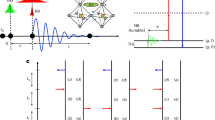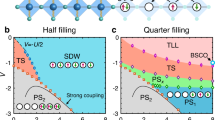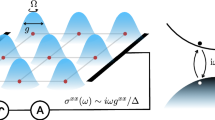Abstract
Electron–phonon coupling is crucial for the existence of various phases of matter, in particular superconductivity and density waves. Here, we devise a theory that incorporates the quantum geometry of the electron bands into the electron–phonon coupling, demonstrating the crucial contributions of the Fubini–Study metric or its orbital selective version to the dimensionless electron–phonon coupling constant. We apply the theory to two materials, that is, graphene and MgB2, where the geometric contributions account for approximately 50% and 90% of the total electron–phonon coupling constant, respectively. The quantum geometric contributions in the two systems are further bounded from below by topological contributions. Our results suggest that the non-trivial electron band geometry or topology might favour superconductivity with a relatively high critical temperature.
This is a preview of subscription content, access via your institution
Access options
Access Nature and 54 other Nature Portfolio journals
Get Nature+, our best-value online-access subscription
$32.99 / 30 days
cancel any time
Subscribe to this journal
Receive 12 print issues and online access
$259.00 per year
only $21.58 per issue
Buy this article
- Purchase on SpringerLink
- Instant access to full article PDF
Prices may be subject to local taxes which are calculated during checkout



Similar content being viewed by others
Data availability
The datasets generated during and/or analysed during the current study are available from the authors on reasonable request. Source data are provided with this paper.
Code availability
The code generated during and/or analysed for the current study is available from the authors on reasonable request.
References
Provost, J. & Vallee, G. Riemannian structure on manifolds of quantum states. Commun. Math. Phys. 76, 289 (1980).
Resta, R. The insulating state of matter: a geometrical theory. Eur. Phys. J. B 79, 121 (2011).
Bradlyn, B. et al. Topological quantum chemistry. Nature 547, 298–305 (2017).
Lieb, E. H. Two theorems on the Hubbard model. Phys. Rev. Lett. 62, 1201 (1989).
Mielke, A. Ferromagnetism in the Hubbard model on line graphs and further considerations. J. Phys. A 24, 3311 (1991).
Călugăru, D. et al. General construction and topological classification of crystalline flat bands. Nat. Phys. 18, 185–189 (2022).
Peotta, S. & Törmä, P. Superfluidity in topologically nontrivial flat bands. Nat. Commun. 6, 8944 (2015).
Törmä, P., Peotta, S. & Bernevig, B. A. Superconductivity, superfluidity and quantum geometry in twisted multilayer systems. Nat. Rev. Phys. 4, 528–542 (2022).
Hosur, P. Circular photogalvanic effect on topological insulator surfaces: Berry-curvature-dependent response. Phys. Rev. B 83, 035309 (2011).
Neupert, T., Chamon, C. & Mudry, C. Measuring the quantum geometry of bloch bands with current noise. Phys. Rev. B 87, 245103 (2013).
Gao, Y., Yang, S. A. & Niu, Q. Field induced positional shift of bloch electrons and its dynamical implications. Phys. Rev. Lett. 112, 166601 (2014).
Morimoto, T. & Nagaosa, N. Topological nature of nonlinear optical effects in solids. Sci. Adv. 2, e1501524 (2016).
de Juan, F., Grushin, A. G., Morimoto, T. & Moore, J. E. Quantized circular photogalvanic effect in Weyl semimetals. Nat. Commun. 8, 15995 (2017).
Liang, L. et al. Band geometry, Berry curvature, and superfluid weight. Phys. Rev. B 95, 024515 (2017).
Ozawa, T. & Goldman, N. Extracting the quantum metric tensor through periodic driving. Phys. Rev. B 97, 201117 (2018).
Li, Y. & Haldane, F. D. M. Topological nodal Cooper pairing in doped Weyl metals. Phys. Rev. Lett. 120, 067003 (2018).
Gao, Y. & Xiao, D. Nonreciprocal directional dichroism induced by the quantum metric dipole. Phys. Rev. Lett. 122, 227402 (2019).
Gianfrate, A. et al. Measurement of the quantum geometric tensor and of the anomalous Hall drift. Nature 578, 381–385 (2020).
Rhim, J.-W., Kim, K. & Yang, B.-J. Quantum distance and anomalous Landau levels of flat bands. Nature 584, 59–63 (2020).
Kozii, V., Avdoshkin, A., Zhong, S. & Moore, J. E. Intrinsic anomalous Hall conductivity in a nonuniform electric field. Phys. Rev. Lett. 126, 156602 (2021).
Chen, W. & Huang, W. Quantum-geometry-induced intrinsic optical anomaly in multiorbital superconductors. Phys. Rev. Res. 3, L042018 (2021).
Ahn, J., Guo, G.-Y., Nagaosa, N. & Vishwanath, A. Riemannian geometry of resonant optical responses. Nat. Phys. 18, 290–295 (2022).
Bardeen, J., Cooper, L. N. & Schrieffer, J. R. Theory of superconductivity. Phys. Rev. 108, 1175 (1957).
Migdal, A. Interaction between electrons and lattice vibrations in a normal metal. Sov. Phys. JETP 7, 996 (1958).
Eliashberg, G. Interactions between electrons and lattice vibrations in a superconductor. Sov. Phys. JETP 11, 696 (1960).
McMillan, W. L. Transition temperature of strong-coupled superconductors. Phys. Rev. 167, 331 (1968).
Allen, P. B. & Dynes, R. C. Transition temperature of strong-coupled superconductors reanalyzed. Phys. Rev. B 12, 905 (1975).
Vergniory, M. G. et al. A complete catalogue of high-quality topological materials. Nature 566, 480–485 (2019).
Zhang, T. et al. Catalogue of topological electronic materials. Nature 566, 475–479 (2019).
Tang, F., Po, H. C., Vishwanath, A. & Wan, X. Comprehensive search for topological materials using symmetry indicators. Nature 566, 486–489 (2019).
Baroni, S., de Gironcoli, S., Dal Corso, A. & Giannozzi, P. Phonons and related crystal properties from density-functional perturbation theory. Rev. Mod. Phys. 73, 515 (2001).
Nagamatsu, J., Nakagawa, N., Muranaka, T., Zenitani, Y. & Akimitsu, J. Superconductivity at 39 K in magnesium diboride. Nature 410, 63–64 (2001).
Bud’ko, S. L. et al. Boron isotope effect in superconducting mgb2. Phys. Rev. Lett. 86, 1877 (2001).
Hinks, D. G., Claus, H. & Jorgensen, J. D. The complex nature of superconductivity in MgB2 as revealed by the reduced total isotope effect. Nature 411, 457–460 (2001).
Esterlis, I. et al. Breakdown of the Migdal–Eliashberg theory: a determinant quantum Monte Carlo study. Phys. Rev. B 97, 140501 (2018).
Sous, J., Chakraborty, M., Krems, R. V. & Berciu, M. Light bipolarons stabilized by peierls electron–phonon coupling. Phys. Rev. Lett. 121, 247001 (2018).
Mitra, T. Electron–phonon interaction in the modified tight-binding approximation. J. Phys. C 2, 52 (1969).
Törmä, P., Liang, L. & Peotta, S. Quantum metric and effective mass of a two-body bound state in a flat band. Phys. Rev. B 98, 220511 (2018).
Castro Neto, A. H., Guinea, F., Peres, N. M. R., Novoselov, K. S. & Geim, A. K. The electronic properties of graphene. Rev. Mod. Phys. 81, 109 (2009).
Tarnopolsky, G., Kruchkov, A. J. & Vishwanath, A. Origin of magic angles in twisted bilayer graphene. Phys. Rev. Lett. 122, 106405 (2019).
Bernevig, B. A., Song, Z.-D., Regnault, N. & Lian, B. Twisted bilayer graphene. III. Interacting Hamiltonian and exact symmetries. Phys. Rev. B 103, 205413 (2021).
Song, Z.-D. & Bernevig, B. A. Magic-angle twisted bilayer graphene as a topological heavy fermion problem. Phys. Rev. Lett. 129, 047601 (2022).
Liu, C.-X., Chen, Y., Yazdani, A. & Bernevig B. A. Electron–K-phonon interaction in twisted bilayer graphene. Preprint at https://arxiv.org/abs/2303.15551 (2023).
Cao, Y. et al. Unconventional superconductivity in magic-angle graphene superlattices. Nature 556, 43–50 (2018).
Kortus, J., Mazin, I. I., Belashchenko, K. D., Antropov, V. P. & Boyer, L. L. Superconductivity of metallic boron in MgB2. Phys. Rev. Lett. 86, 4656 (2001).
An, J. M. & Pickett, W. E. Superconductivity of MgB2: covalent bonds driven metallic. Phys. Rev. Lett. 86, 4366 (2001).
Kong, Y., Dolgov, O. V., Jepsen, O. & Andersen, O. K. Electron–phonon interaction in the normal and superconducting states of MgB2. Phys. Rev. B 64, 020501 (2001).
Shukla, A. et al. Phonon dispersion and lifetimes in MgB2. Phys. Rev. Lett. 90, 095506 (2003).
Jin, K.-H. et al. Topological superconducting phase in high-Tc superconductor MgB2 with Dirac–nodal-line fermions. npj Comput. Mater. 5, 57 (2019).
Aroyo, M. I. et al. Bilbao crystallographic server: I. databases and crystallographic computing programs. Z. Kristallogr. Cryst. Mater. 221, 15 (2006).
Ahn, J., Park, S. & Yang, B.-J. Failure of Nielsen–Ninomiya theorem and fragile topology in two-dimensional systems with space–time inversion symmetry: application to twisted bilayer graphene at magic angle. Phys. Rev. X 9, 021013 (2019).
Yan, J., Zhang, Y., Kim, P. & Pinczuk, A. Electric field effect tuning of electron–phonon coupling in graphene. Phys. Rev. Lett. 98, 166802 (2007).
Maultzsch, J., Reich, S., Thomsen, C., Requardt, H. & Ordejón, P. Phonon dispersion in graphite. Phys. Rev. Lett. 92, 075501 (2004).
Zhu, X. et al. Electron–phonon coupling on the surface of the topological insulator Bi2Se3 determined from surface-phonon dispersion measurements. Phys. Rev. Lett. 108, 185501 (2012).
Sipe, J. E. & Shkrebtii, A. I. Second-order optical response in semiconductors. Phys. Rev. B 61, 5337 (2000).
Chen, Y. et al. Experimental realization of a three-dimensional topological insulator, Bi2Te3. Science 325, 178 (2009).
Hatch, R. C. et al. Stability of the Bi2Se3(111) topological state: electron–phonon and electron–defect scattering. Phys. Rev. B 83, 241303 (2011).
Wang, Y., Plackowski, T. & Junod, A. Specific heat in the superconducting and normal state (2–300 K, 0–16 T), and magnetic susceptibility of the 38 K superconductor MgB2: evidence for a multicomponent gap. Physica C 355, 179 (2001).
Korshunovet, A. et al. Softening of a flat phonon mode in the kagome ScV6Sn6. Nat. Commun. 14, 6646 (2023).
Acknowledgements
We acknowledge E. Baldini, D. Calugaru, M. Cheng, S. Das Sarma, L. Glazman, F. D. M. Haldane, J. Herzog-Arbeitman, H. Hu, L.-H. Hu, Y. H. Kwan, B. Lian, C. -Hwan Park, Z.-D. Song, I. Souza, J. Sous, X.-Q. Sun, P. Törmä, Y. Xu, R.-X. Zhang and especially C.-X. Liu for helpful discussion. B.A.B.’s research was supported by the European Research Council under the European Union’s Horizon 2020 research and innovation programme (grant agreement no. 101020833) and partially by the Simons Investigator grant no. 404513, the Gordon and Betty Moore Foundation through grant no. GBMF8685 towards the Princeton theory programme, the Gordon and Betty Moore Foundation’s EPiQS Initiative (grant no. GBMF11070), the Office of Naval Research (grant no. N00014-20-1-2303), the Global Collaborative Network Grant at Princeton University, the BSF Israel–US Foundation (no. 2018226) and the NSF-MERSEC (grant no. MERSEC DMR 2011750). J.Y. is supported by the Gordon and Betty Moore Foundation through grant no. GBMF8685 toward the Princeton theory programme. I.E. and B.A.B. are part of the SuperC collaboration. I.E. has received funding from the European Research Council under the European Union’s Horizon 2020 research and innovation programme (grant agreement no. 802533) and the Department of Education, Universities and Research of the Eusko Jaurlaritza and the University of the Basque Country UPV/EHU (grant no. IT1527-22). Calculations by C.J.C. and P.N. were supported by Office of Naval Research grant no. 13672292 and by Gordon and Betty Moore Foundation grant no. 8048. P.N. gratefully acknowledges support from the Alexander von Humboldt Foundation (Bessel Research Award) and from the John Simon Guggenheim Memorial Foundation (Guggenheim Fellowship).
Author information
Authors and Affiliations
Contributions
J.Y. and B.A.B. conceived and supervised the project. J.Y. and B.A.B. performed the theoretical analysis. C.J.C., R.B., I.E. and P.N. performed the ab initio calculations. J.Y. and B.A.B. wrote the paper, with input from C.J.C., R.B., I.E. and P.N.
Corresponding author
Ethics declarations
Competing interests
The authors declare no competing interests.
Peer review
Peer review information
Nature Physics thanks the anonymous reviewers for their contribution to the peer review of this work.
Additional information
Publisher’s note Springer Nature remains neutral with regard to jurisdictional claims in published maps and institutional affiliations.
Supplementary information
Supplementary Information
Supplementary Figs. 1–10, Discussion and Tables I and II.
Source data
Source Data Fig. 2
Data obtained from numerical calculations for Fig. 2.
Source Data Fig. 3
Data obtained from numerical calculations for Fig. 3.
Rights and permissions
Springer Nature or its licensor (e.g. a society or other partner) holds exclusive rights to this article under a publishing agreement with the author(s) or other rightsholder(s); author self-archiving of the accepted manuscript version of this article is solely governed by the terms of such publishing agreement and applicable law.
About this article
Cite this article
Yu, J., Ciccarino, C.J., Bianco, R. et al. Non-trivial quantum geometry and the strength of electron–phonon coupling. Nat. Phys. 20, 1262–1268 (2024). https://doi.org/10.1038/s41567-024-02486-0
Received:
Accepted:
Published:
Issue date:
DOI: https://doi.org/10.1038/s41567-024-02486-0
This article is cited by
-
Anomalous coherence length in superconductors with quantum metric
Communications Physics (2025)
-
Quasi-localization and Wannier obstruction in partially flat bands
Communications Physics (2024)



